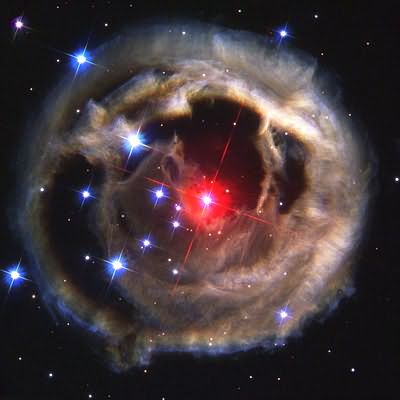 The Hubble Space Telescope hovers at the boundary of Earth and space in this picture, taken after Hubble’s second servicing mission in 1997. Hubble drifts 353 miles (569 km) above the Earth’s surface, where it can avoid the atmosphere and clearly see objects in space.*
The Hubble Space Telescope hovers at the boundary of Earth and space in this picture, taken after Hubble’s second servicing mission in 1997. Hubble drifts 353 miles (569 km) above the Earth’s surface, where it can avoid the atmosphere and clearly see objects in space.* This image is courtesy of the new Near Infrared Camera and Multi-Object Spectrometer (NICMOS), which has taken its first peek at Saturn. The false-color image—taken January 4, 1998—shows the planet’s reflected infrared light. This view provides detailed information on the clouds and hazes in Saturn’s atmosphere.*
This image is courtesy of the new Near Infrared Camera and Multi-Object Spectrometer (NICMOS), which has taken its first peek at Saturn. The false-color image—taken January 4, 1998—shows the planet’s reflected infrared light. This view provides detailed information on the clouds and hazes in Saturn’s atmosphere.*
 This NASA Hubble Space Telescope image shows one of the most complex planetary nebulae ever seen, NGC 6543, nicknamed the "Cat's Eye Nebula." Hubble reveals surprisingly intricate structures including concentric gas shells, jets of high-speed gas and unusual shock-induced knots of gas. Estimated to be 1,000 years old, the nebula is a visual "fossil record" of the dynamics and late evolution of a dying star.
This NASA Hubble Space Telescope image shows one of the most complex planetary nebulae ever seen, NGC 6543, nicknamed the "Cat's Eye Nebula." Hubble reveals surprisingly intricate structures including concentric gas shells, jets of high-speed gas and unusual shock-induced knots of gas. Estimated to be 1,000 years old, the nebula is a visual "fossil record" of the dynamics and late evolution of a dying star.
This color picture, taken with the Wide Field Planetary Camera-2, is a composite of three images taken at different wavelengths. The image was taken on September 18, 1994. NGC 6543 is 3,000 light-years away in the northern constellation Draco.*
 NASA’s Spitzer and Hubble Space Telescopes joined forces to create this striking composite image of one of the most popular sights in the universe. Messier 104 is commonly known as the Sombrero galaxy because in visible light, it resembles the broad-brimmed Mexican hat. However, in Spitzer’s striking infrared view, the galaxy looks more like a ”bull’s eye.”
NASA’s Spitzer and Hubble Space Telescopes joined forces to create this striking composite image of one of the most popular sights in the universe. Messier 104 is commonly known as the Sombrero galaxy because in visible light, it resembles the broad-brimmed Mexican hat. However, in Spitzer’s striking infrared view, the galaxy looks more like a ”bull’s eye.”
M104 is a rich system of globular clusters, estimated to be nearly 2,000 in number—10 times as many as orbit our Milky Way galaxy. At a relatively bright magnitude of +8, M104 is just beyond the limit of naked-eye visibility. The galaxy is 50,000 light-years across and is located 28 million light years from Earth.*
 In January, 2002, a dull star in an obscure constellation suddenly became 600,000 times more luminous than our Sun, temporarily making it the brightest star in our Milky Way galaxy. The mysterious star, called V838 Monocerotis, has long since faded back to obscurity. But observations by NASA's Hubble Space Telescope of a phenomenon called a "light echo" around the star have uncovered remarkable new features. These details promise to provide astronomers with a CAT-scan-like probe of the three-dimensional structure of shells of dust surrounding an aging star.*
In January, 2002, a dull star in an obscure constellation suddenly became 600,000 times more luminous than our Sun, temporarily making it the brightest star in our Milky Way galaxy. The mysterious star, called V838 Monocerotis, has long since faded back to obscurity. But observations by NASA's Hubble Space Telescope of a phenomenon called a "light echo" around the star have uncovered remarkable new features. These details promise to provide astronomers with a CAT-scan-like probe of the three-dimensional structure of shells of dust surrounding an aging star.*
Read more about the Hubble Space Telescope: http://hubblesite.org/
No comments:
Post a Comment